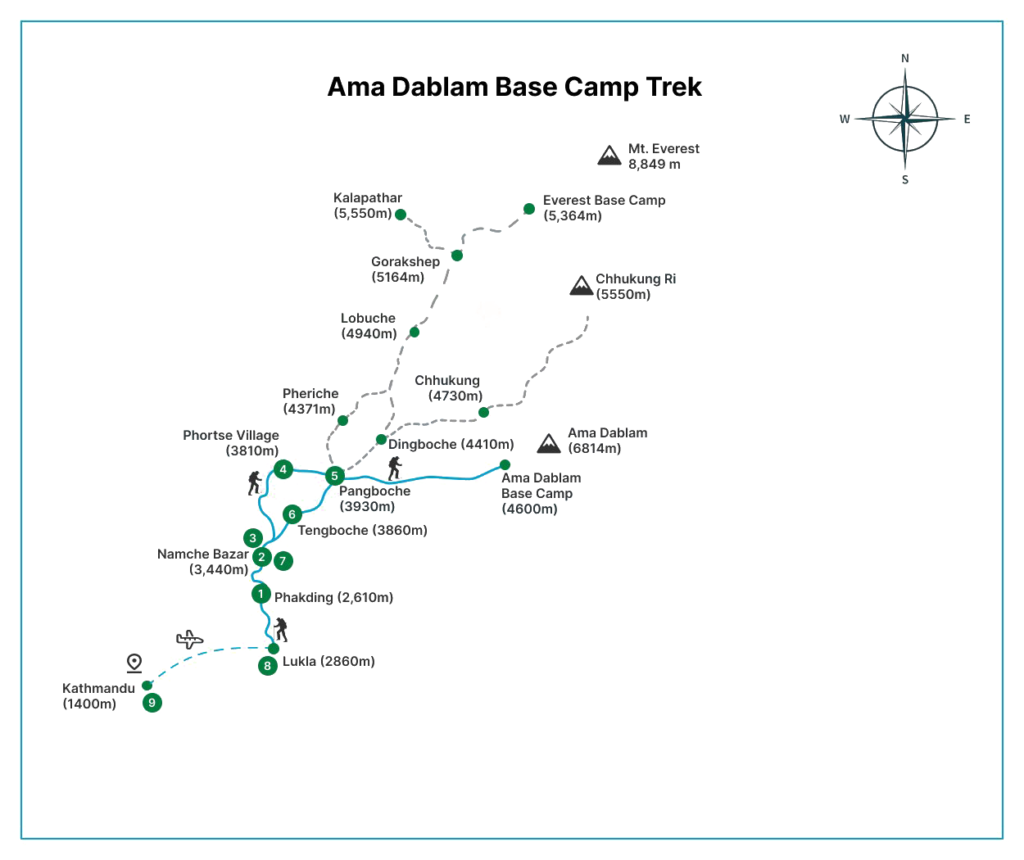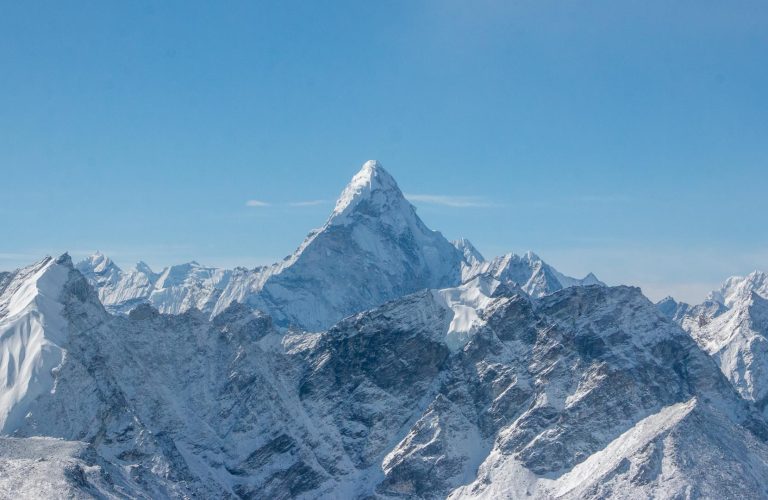Ama Dablam
Ama Dablam is a mountain in the eastern Himalayan range of Koshi Province, Nepal. The main peak is 6,812 metres (22,349 ft), the lower western peak is 6,170 metres (20,243 ft).
€ 7500/ Per Person

About Ama Dablam
Ama Dablam is a mountain in the eastern Himalayan range of Koshi Province, Nepal. The main peak is 6,812 metres (22,349 ft), the lower western peak is 6,170 metres (20,243 ft). Ama Dablam means “mother’s necklace”; the long ridges on each side like the arms of a mother (ama) protecting her child, and the hanging glacier thought of as the dablam, the traditional double-pendant containing pictures of the gods, worn by Sherpa women.[3] For several days, Ama Dablam dominates the eastern sky for anyone trekking to Mount Everest Base Camp. For its soaring ridges and steep faces Ama Dablam is sometimes referred as the “Matterhorn of the Himalayas.”[4] The mountain is featured on the one rupee Nepalese banknote.
Although Alfred Gregory led the first attempt on Ama Dablam in 1958[6] it was on 13 March 1961 that the first successful ascent was made, when Mike Gill (NZ), Barry Bishop (US), Mike Ward (UK) and Wally Romanes (NZ) ascended the Southwest Ridge. They were well-acclimatised to altitude, having wintered over at 5,800 metres (19,029 ft) near the base of the peak as part of the 1960–61 Silver Hut expedition, led by Sir Edmund Hillary.
Situated at a distance of 162 km (101 mi) north of the provincial capital of Biratnagar and 152 km (94 mi) northeast to Kathmandu, Ama Dablam is the third most popular Himalayan peak for permitted expeditions. The most popular route by far is the Southwest Ridge (right skyline in the photo).[8] Prior to a 2006 avalanche, climbers typically set up three camps along the ridge with Camp III just below and to the right of the hanging glacier, the Dablam. Any ice that calves off the glacier typically goes left, away from the camp. However, after the avalanche, climbers now prefer to set just two camps to minimize risk. Camp I is at an altitude of over 5,800 metres (19,029 ft), and Camp II is at an altitude of over 6,000 metres (19,685 ft). A climbing permit and a liaison officer are required when attempting Ama Dablam. As with Mount Everest, the best climbing months are April and May (before the monsoon) and September and October.

Years of service



 Day 01 Arrive Kathmandu
Day 01 Arrive Kathmandu
 Day 02 Rest/preparation
Day 02 Rest/preparation
 Day 03 Fly Lukla trek to Phakding
Day 03 Fly Lukla trek to Phakding
 Day 04 Trek Namche Bazaar (3420m)
Day 04 Trek Namche Bazaar (3420m)
 Day 05 Rest/acclimatization
Day 05 Rest/acclimatization
 Day 06 Trek Tengboche (3870m)
Day 06 Trek Tengboche (3870m)
 Day 07 Trek Dingboche (4360m)
Day 07 Trek Dingboche (4360m)
 Day 08 Rest/acclimatization
Day 08 Rest/acclimatization
 Day 09 Trek Lobuche (4930m)
Day 09 Trek Lobuche (4930m)
 Day 10 Trek Gorak Shep; visit EVC
Day 10 Trek Gorak Shep; visit EVC
 Day 11 Trek Pheriche via Kala Patthar
Day 11 Trek Pheriche via Kala Patthar
 Day 12 Trek Namche Bazaar
Day 12 Trek Namche Bazaar
 Day 13 Trek Lukla
Day 13 Trek Lukla
 Day 14 Fly Kathmandu via Helicopter
Day 14 Fly Kathmandu via Helicopter
 Day 15 Depart Kathmandu
Day 15 Depart Kathmandu
 All Ground Transportation.
All Ground Transportation.
 3 nights accommodation on BB Plan (sharing)
3 nights accommodation on BB Plan (sharing)
 Accommodation & meals during the trek
Accommodation & meals during the trek
 Airfare: Lukla- Kathmandu- Lukla (Heli)
Airfare: Lukla- Kathmandu- Lukla (Heli)
 Experienced Guide with required no. of porter
Experienced Guide with required no. of porter
 Staff expenses (salary, insurance, equipment, domestic airfare, food, and accommodation)
Staff expenses (salary, insurance, equipment, domestic airfare, food, and accommodation)
 All Required permit
All Required permit
 Nepal arrival visa and international flights.
Nepal arrival visa and international flights.
 Any meals in Kathmandu.
Any meals in Kathmandu.
 Your personal equipment
Your personal equipment
 Personal Expenses during trek
Personal Expenses during trek
 Travel insurance | Tips to guide, porters
Travel insurance | Tips to guide, porters
 Any other expenses or charges that are not mentioned in the “cost includes” list.
Any other expenses or charges that are not mentioned in the “cost includes” list.


DAY 1 - 2 | International flight to Kathmandu.
DAY 3 | Kathmandu Local place visit
Day enjoying the ‘bombardment of the senses’ that is Kathmandu. Sightseeing tours can be arranged and would include visiting the temples of Bodnath, Swayambhunath (The Monkey Temple), Pashupatinath and Durbar Square. Simply wandering around the huge array of shops, markets, cafes, bars and restaurants in Thamel is a fascinating experience.
DAY 4 | Fly to Lukla (2800m) Trek to Phakding (2610m).
Fly to Lukla (2800m) Trek to Phakding (2610m). A spectacular short internal flight takes us to this tiny airstrip town and the gateway to the Sherpa Kingdom. After lunch we start our short trek along the typically stony path that descends from the forested terraces of Lukla right into the Dudh Kosi valley and the brightly painted lodges of Phakding. There are good views of Kusum Kanguru’s North Face (6367m)
DAY 5 | Phakding to Namche Bazaar (3440m).
Phakding to Namche Bazaar (3440m). Into the Sherpa capital and the heart of the Khumbu. You will now be becoming familiar with local protocol for passing chortens, mani stones, yaks, spinning prayer wheels etc. and enjoying the hustle and bustle of trekking and everyday life that exists on the ‘Everest Trail’. At Monjo we enter Sagarmartha National Park and can visit the small visitor centre there. Four hours.
DAY 6 | Rest Day in Namche Bazaar
Rest Day in Namche Bazaar. It is important to have a couple of nights and a rest day in Namche before proceeding any higher. You can spend the day taking short walks up to Thami or Khumjung, visiting the Everest and Ama Dablam viewpoints or just relaxing and exploring the narrow streets of the busy Sherpa capital.
DAY 7 | Namche Bazaar to Pangboche (3930m).
Namche Bazaar to Pangboche (3930m). We climb steeply out of Namche, turn the corner, and are immediately presented with superb views of Everest, Lhotse, Nuptse and our destination, Ama Dablam. Crossing the Dudh Kosi involves a steep descent to Phunki Thanghka and its fine water driven prayer wheels before re-ascending to Thyangboche. The famous Sherpa monastery can be visited here, and the surrounding panorama is rightly deemed to be one of the most magnificent mountain viewpoints in the world. The going is easy now and Pangboche, the highest year-round settlement in the valley, is soon reached. Six hours.
DAY 8 | Pangboche to Ama Dablam Base Camp
Pangboche to Ama Dablam Base Camp (4750m). We leave the busy Everest trail and cross the Imja Khola. Climbing steeply out of the valley and above the tree line we enter the alpine meadows that provide such a fine location for a base camp, no cold and scrappy glacier moraine sites here!
DAY 9 | Rest Day at Base Camp
Rest Day at Base Camp. Another acclimatisation day spent exploring the alpine meadows and views around camp, packing gear for higher on the mountain and relaxing in this very pleasant spot.
DAY 10 -25 | Ascent of Ama Dablam, South West Ridge.
Ascent of Ama Dablam, South West Ridge. See section entitled ‘The Climbing Day’.
DAY 26 | Base Camp to Thyangboche
Base Camp to Thyangboche (3860m). On the return trek folk have the option of staying in places not visited on the way up or returning to the more western style luxuries available in Namche.
DAY 27 | Thyangboche to Monjo
Thyangboche to Monjo (2840m). You will now really feel the warmth and rich air of the forest zone.
DAY 28 | Monjo to Lukla
Monjo to Lukla. The Alpine mountain hut atmosphere of Paradise Lodge in Lukla is the ideal place to relax and celebrate your journeys end.
DAY 29 | Fly Lukla to Kathmandu.
Fly Lukla to Kathmandu. Back to the comforts of our hotel in Thamel and the enjoyable hustle and bustle. This is a good time to buy souvenirs and try your hand at haggling with the local shopkeepers. We will dine in one of Kathmandu’s finest restaurants and experience some local dancing styles!
DAY 30 | Return flight from Kathmandu.
Return flight from Kathmandu. The flight usually departs late afternoon so you will have a final morning free in Kathmandu.
- All Ground Transportation.
- 3 nights accommodation on BB Plan (sharing)
- Accommodation & meals during the trek
- Airfare: Lukla- Kathmandu- Lukla (Heli)
- Experienced Guide with required no. of porter
- Staff expenses (salary, insurance, equipment, domestic airfare, food, and accommodation)
- All Required permit
- Nepal arrival visa and international flights.
- Any meals in Kathmandu.
- Your personal equipment
- Personal Expenses during trek
- Travel insurance | Tips to guide, porters
- Any other expenses or charges that are not mentioned in the “cost includes” list.






